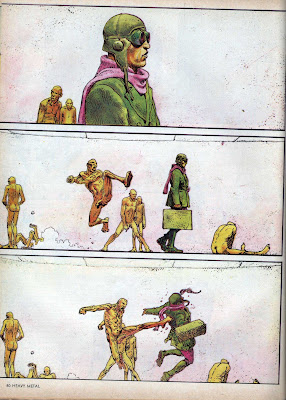Book Review: 'New Dimensions IV', edited by Robert Silverberg
2 / 5 Stars
‘New Dimensions’ was of course one of the two major, yearly sf anthologies that featured 'New Wave' content (the other being Damon Knight’s ‘Orbit’ series) during the movement’s heyday in the 70s.
‘New Dimensions IV’ was published as a Signet paperback in October 1974; the cover artist is uncredited.
In contrast to Damon Knight's policy in 'Orbit', editor Silverberg approached the New Dimensions imprint a bit more inclined to include traditionally structured stories, along with the obligatory ‘Speculative Fiction’ content. So it was with ‘New Dimensions IV’.
My thoughts on the entries:
Richard A. Lupoff’s ‘After the Dreamtime’ takes the traditional starship-as-a-sailing ship theme, and crews it with a spacefaring race of Australian Aborigines. Somewhat inevitably, a shipload of snobby white people is invoked to remind the reader of the racism and other tribulations visited upon our noble Aborigines. All else aside, 'Dreamtime' s clear writing and straightforward plotting make it one of the better stories in the collection.
Laurence M. Janifer’s ‘The Bible After Apocalypse’ is a vague tale of bewildered humans reacting, in half-hearted, existential fashion, to an alien invasion.
Felix C. Gotschalk contributes two stories. ‘Outer Concentric’ is a satirical look at old age, and retirement, in a dystopian future. ‘The Examination’ is an absurdist treatment of a test proctor who finds out that the little girl to whom he is administering an IQ exam may have more to her than is apparent to the eye. Both of these stories suffer from labored, overly wordy prose, and are stark examples of how poorly most New Wave fiction has aged in the years since it was first written.
Terry Carr’s ‘The Colors of Fear’ is another of the more accessible tales in the collection. ‘Colors’ features a decrepit Earth under siege by a race of nebulous aliens. The story’s imaginative quality, fused with uncontrived prose, gives it an offbeat edge otherwise absent in most New Wave treatments of this same theme.
Roger Elwood’s ‘Ariel’ is an awkward tale of a black astronaut and his efforts to escape bigotry in a dystopian, near-future US. The story, which consists of a linked series of short paragraphs, suffers from all sorts of New Wave contrivances: stream-of-consciousness musings on the part of the narrator, segments of vertically aligned ALL CAPS text, figurative descriptions of otherworldly vistas, etc., etc.
Three entries: ‘State of the Art’ by Barry Malzberg, ‘Among the Metal-and-People People’, by David R. Bunch, and ‘Animal Fair’, by R. A. Lafferty, vie for the dubious honor of being the worst in the anthology. Malzberg’s tale features famous authors arguing among themselves in some sort of ‘afterlife’ version of Paris. Bunch’s story deals with a military robot who makes an expedition to confront an adversary, while Lafferty’s tale deals with a suburban backyard that attracts a bevy of talking animals. All are overly-earnest efforts at crafting absurdist, 'Speculative Fiction' pieces.
At novelette length, Gardner Dozois’s ‘Strangers’ is easily the longest story in the collection. ‘Strangers’ features as its main character a Swiss citizen named Joseph Farber. Farber is a stolid, unimaginative man, one of a number of staffers of the Terran enclave on the planet Lisle, home to the feline, humanoid race known as the Cian.
Lonely, and alienated from his fellow Terrans, Farber begins a romance with a Cian female and eventually marries her, although with the realization that many aspects of their society are withheld from his knowledge. As he embarks on life as a stranger among the reticent, rather xenophobic Cian, Farber gradually learns some stark truths about marriage and family among his adopted culture.
‘Strangers’ is a slow-paced piece, filled with many descriptive passages and quasi-philosophical musings, and author Dozois is deliberate in unveiling revelations about Cian society to his readers. Much of the novelette’s air of increasing disquiet is the result of the limited intelligence and imagination of Farber, its Terran protagonist. Nonetheless, readers willing to shoulder a contemplative treatment of an alien society will find ‘Strangers’ to be another of the better entries in the anthology.
Summing up, ‘New Dimensions IV’ (not surprisingly) showcases the Speculative Fiction content much in vogue in sf during the 70s. I suspect modern audiences will be underwhelmed by this content; however, those readers who persevere will find several stories worthy of their time.























































.jpg)























